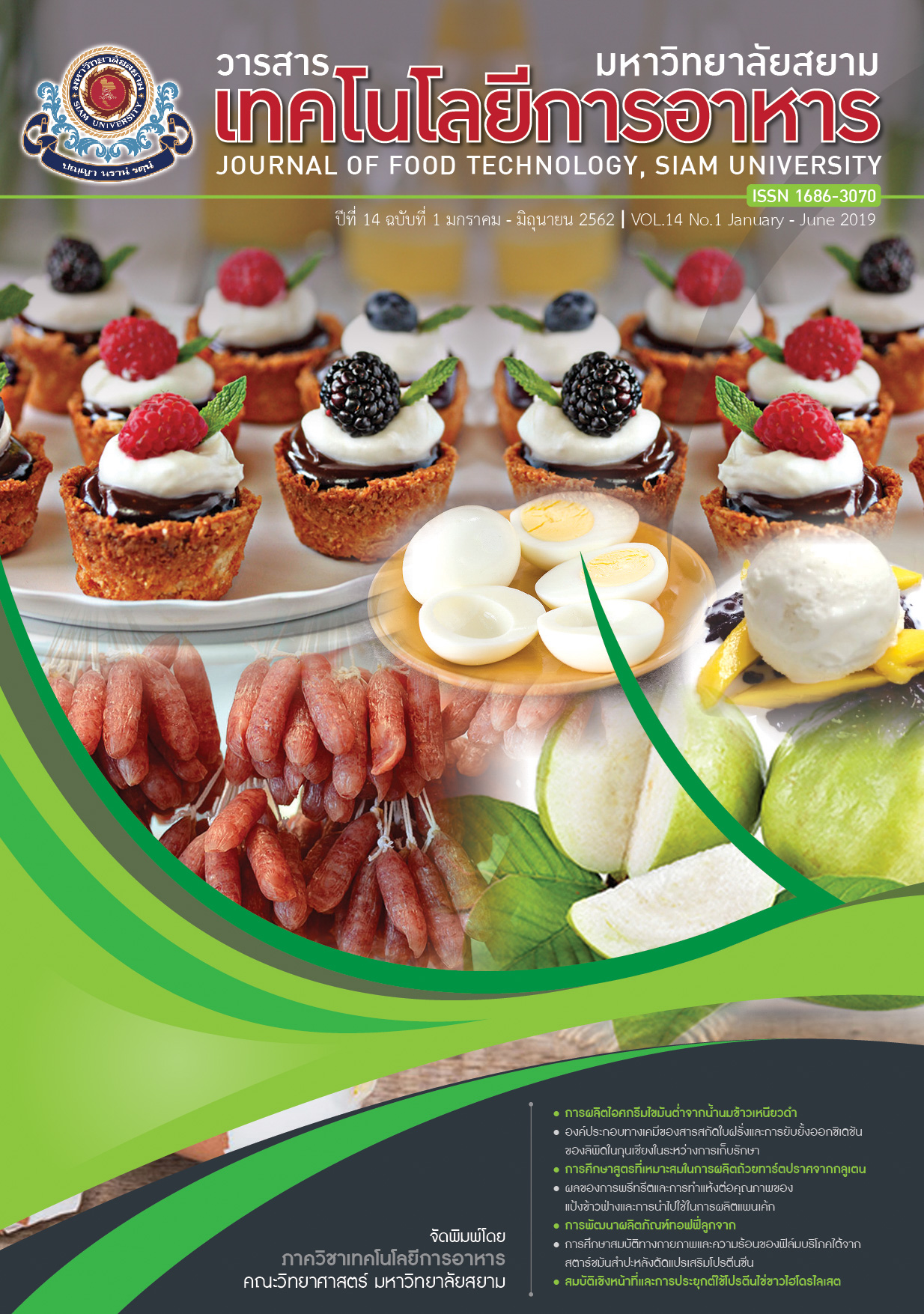การศึกษาสูตรที่เหมาะสมในการผลิตถ้วยทาร์ตปราศจากกลูเตน
Main Article Content
บทคัดย่อ
งานวิจัยนี้มีวัตถุประสงค์เพื่อศึกษาอัตราส่วนที่เหมาะสมในการผลิตถ้วยทาร์ตปราศจากกลูเตน โดยวางแผนการทดลองแบบมิกเจอร์ดีไซน์ ได้ส่วนประกอบหลักของถ้วยทาร์ตจำนวน 13 สูตร ซึ่งประกอบด้วยแป้งผสม (แป้งข้าวเจ้า แป้งมันฝรั่ง และแป้งมันสำปะหลัง) เนยสดชนิดเค็ม และน้ำตาลไอซิ่ง ประเมินคุณสมบัติทางกายภาพและทดสอบการยอมรับทางประสาทสัมผัสกับผู้ทดสอบทั่วไป ข้อมูลที่วิเคราะห์ได้จากพื้นผิวตอบสนองของกราฟคอนทัวร์ พบว่า ร้อยละการสูญเสียระหว่างการอบของถ้วยทาร์ตแปรผันตรงกับปริมาณแป้งผสมและเนยสดชนิดเค็ม ค่าปริมาตรจำเพาะแปรผันตรงกับปริมาณเนย และค่าความแข็งแปรผันตรงกับปริมาณแป้งผสม สูตรที่เหมาะสมในการผลิตถ้วยทาร์ตปราศจากกลูเตนคือสูตรที่มีแป้งผสม เนยสดชนิดเค็ม และน้ำตาลไอซิ่ง ร้อยละ 50 30 และ 20 ตามลำดับ เป็นสูตรที่ได้คะแนนการยอมรับด้านลักษณะปรากฏ กลิ่น รสชาติ เนื้อสัมผัส และความชอบรวมสูงที่สุด จากนั้นศึกษาการเสริมจมูกข้าวไรซ์เบอรี่ งาดำ และสาหร่าย พบว่า สูตรที่มีการเสริมงาดำได้รับคะแนนการประเมินทางประสาทสัมผัสด้านความชอบรวมสูงที่สุด (8.13+0.78 คะแนน) อยู่ในระดับชอบปานกลาง ดังนั้นผลิตภัณฑ์ถ้วยทาร์ตปราศจาก กลูเตนเป็นทางเลือกให้กับผู้บริโภคที่ต้องการหลีกเลี่ยงอาหารที่มีส่วนผสมของกลูเตนได้
Article Details
บทความทุกบทความในวารสารเทคโนโลยีการอาหาร ทั้งในรูปแบบสิ่งพิมพ์ และในระบบออนไลน์ ถือเป็นลิขสิทธิ์ของมหาวิทยาลัยสยาม และได้รับการคุ้มครองตามกฎหมาย
เอกสารอ้างอิง
standards.html. [Accessed May, 31, 2018]
[2] Rattanapanone, N. Food chemistry. Bangkok: Odeon Store, 2006, 504.
[3] Fitterman, L. Inside the race for a celiac disease treatment. 2018. [Online] Available from: https://www.allergicliving.com. [Accessed May, 30, 2018]
[4] Surojanametakul, V. Coeliac disease and the importance of gluten-free foods. Food Journal (Thailand), 2013, 43, 16-21.
[5] Charoenphun, N. Development of cookie products from sweet potato. Journal of Food Technology, Siam University, 2018, 13, 32-43.
[6] Somboonpanyakul, P., Hudthagosol, C., Meekhruerod, A., Lasukhang, W. and Chuaduangpuy, D. Development of sinlek brown rice cookie. Agricultural Science Journal, 2012, 43, 565-568.
[7] Charoenphun, N. and Kwanhian, W. Effect of flour from durian waste on quality of gluten free pasta. Thammasat Journal of Science and Technology, 2018, 26, 803-814.
[8] Inchuen, S., Naratippakorn, T. and Kheawruang, S. Effect of holy basil leaf powder on wheat flour property and cookies quality. Khon Kaen Agriculture Journal, 2018, 46, 1387-1394.
[9] Sharma, P. and H. Gujral. Cookie making behavior of wheat-barley flour blends and effects on antioxidant properties. LWT – Food Science and Technology, 2014, 55, 301-307.
[10] Duncan, D. B. Multiple range and multiple F tests. Biometrics, 1995, 11, 1–42.
[11] Kotoki, D. and Deka, S. C. Baking loss of bread with special emphasis on increasing water holding capacity. Journal of Food Science and Technology, 2010, 47, 128-131.
[12] Luangsakul, N., Katekasem, P., Suksawang, M. and Pornanansiri, S. The effects of the amount and type of wheat flour and mixing method on the quality of fortune cookies.
2012. [Online] Available from: https://www.lib.ku.ac.th/KUCONF/2555/KC4906034.pdf [Accessed May, 30, 2018]
[13] Naiwikun, O. Rice: Science and Technology. Bangkok: Kasetsart, 2007, 366.
[14] Ratthanatham, P., Laohakunjit, N. and Kerdchoechuen, O. Phenolic compound, anthocyanin and antioxidant activity of germinated colored rice. Agricultural Science Journal, 2013, 44, 441-444.
[15] Srisayam, M., Weerapreeyakul, N. and Sribuarin, P. In vitro antioxidant activity of white, black and red sesame seeds. Isan Journal of Pharmaceutical Sciences, 2014, 10, 136-146.
[16] Yangthong, M. and Thawonsuwan, J. Nutritional evaluation and antibacterial activity of seaweeds. Journal of Fisheries Technology Research, 2016, 10, 68-77.


